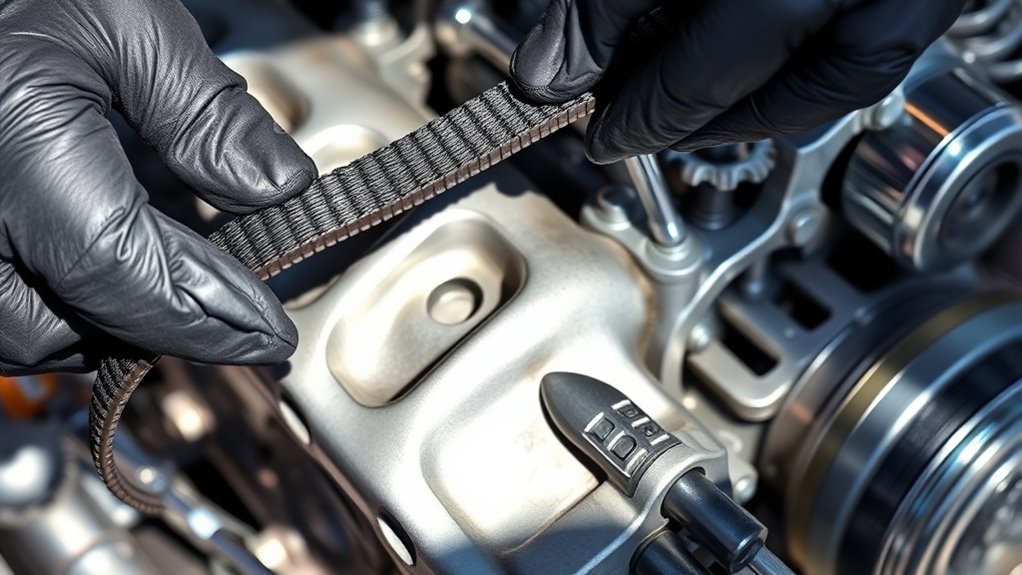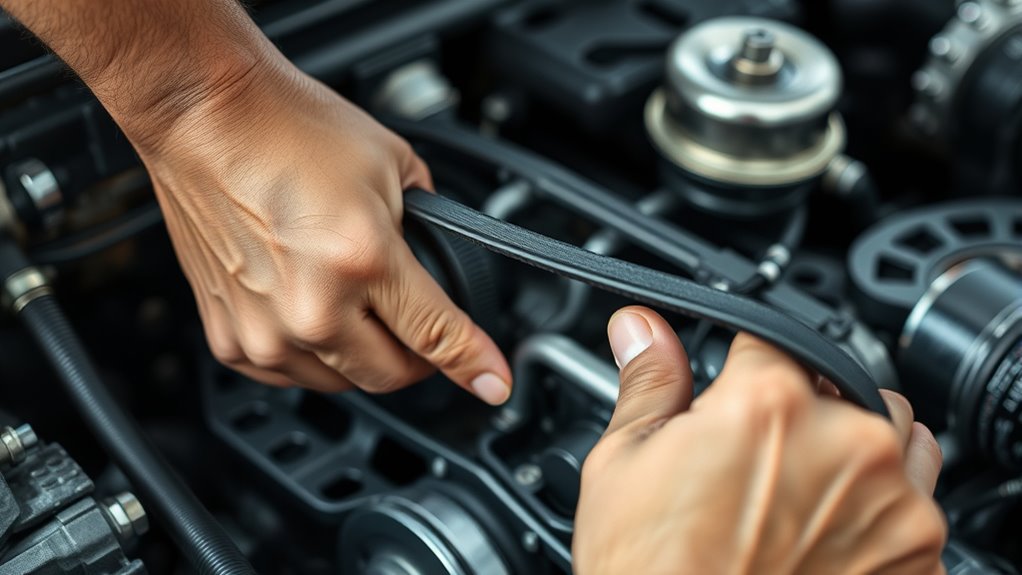Replacing your timing belt on schedule is essential to prevent engine damage and keep your vehicle running smoothly. You’ll need to remove accessories, set the proper tension, and double-check the timing marks for accuracy. Proper belt tension is critical—too loose or too tight can cause wear or engine misfire. Maintaining the correct tension ensures smooth operation and reliable performance. Keep in mind that learning more about the process will help you do the job right every time.
Key Takeaways
- Replacing the timing belt prevents engine damage by maintaining proper timing and avoiding belt failure.
- Proper belt tension is critical; too tight or loose can cause wear, misalignment, or engine performance issues.
- Follow manufacturer guidelines for tension adjustment using gauges or automatic tensioners during replacement.
- Regular inspection of the belt and tensioner components ensures reliable operation and prevents unexpected failures.
- Double-checking timing marks after installation ensures correct synchronization of engine components.

Replacing your timing belt is a essential maintenance task that helps prevent engine damage and guarantees your vehicle runs smoothly. The timing belt plays a pivotal role in maintaining engine timing, ensuring that the camshaft and crankshaft rotate in perfect synchronization. If the belt slips or breaks, the engine’s valves and pistons can collide, leading to costly repairs. That’s why timely replacement is indispensable for your vehicle’s health and performance.
When you’re preparing to replace your timing belt, one of the most important aspects to focus on is belt tension. Proper belt tension ensures that the timing belt maintains the correct grip on the pulleys and gears. If the belt is too loose, it can slip, causing engine timing to go out of sync, which leads to rough operation, poor fuel economy, or even engine failure. Conversely, if it’s too tight, it puts excessive strain on the belt and pulleys, accelerating wear and risking damage to engine components. Achieving the right tension is essential, and often, manufacturers specify a precise tension setting or provide a tensioner to automatically maintain ideal tension.
Adjusting the belt tension involves carefully following the manufacturer’s specifications. You’ll typically need a tension gauge or a specific method to check the tension, depending on your vehicle. Many modern cars have automatic tensioners that keep the belt tight without manual adjustments, but it’s still indispensable to inspect these components regularly. When replacing the belt, you’ll need to remove accessory belts and possibly other components to access the timing cover. Once you have the new belt in place, you’ll use the tensioner to set the proper belt tension, ensuring the timing marks align as specified. This step is essential because incorrect timing can throw your engine off, reduce efficiency, or cause damage.
Proper engine timing is fundamental to your vehicle’s performance, and the tension of the timing belt directly impacts that timing. If you neglect to set the correct tension, you risk misfiring, decreased power, or even catastrophic engine problems. Regular inspections and following the manufacturer’s guidelines will help you identify any signs of wear or loose tension before they cause major issues. Remember, a well-maintained timing belt with correct tension keeps your engine running smoothly, maximizes fuel efficiency, and prolongs the life of your engine components. Always prioritize precise tension adjustment during replacement, and don’t forget to double-check the timing marks before finishing the job. This is especially important because proper belt tension is critical for maintaining engine timing and avoiding costly repairs. That way, you ensure your engine’s timing remains accurate, and your vehicle performs reliably for miles to come.
Frequently Asked Questions
How Much Does Timing Belt Replacement Typically Cost?
A timing belt replacement usually costs between $500 and $1,000, depending on your vehicle and location. You should expect a cost estimate that covers parts and labor, with some vehicles requiring more extensive work. Keep in mind the service interval, which is typically every 60,000 to 100,000 miles. Regularly scheduled replacements help prevent costly engine damage, saving you money in the long run.
Can I Drive My Car After the Belt Is Changed?
Yes, you can drive your car after the timing belt is replaced, but you should do so with caution. Make sure the mechanic has thoroughly checked your vehicle for driving safety and ideal vehicle performance. It’s best to take a short test drive to confirm everything’s working smoothly. If you notice any unusual noises or issues, stop driving and have your mechanic inspect it again. Proper post-replacement checks help maintain your car’s reliability.
What Are the Signs of a Failing Timing Belt?
You’ll notice signs of a failing timing belt, like belt wear such as cracks, fraying, or missing teeth. You might also hear unusual engine noise, like squealing or ticking sounds, which indicate the belt isn’t functioning properly. If you see these signs, it’s essential to get your belt inspected and replaced promptly to avoid engine damage. Ignoring these signals can lead to costly repairs or breakdowns.
How Often Should I Have My Timing Belt Inspected?
Timing belts typically need inspection every 60,000 to 100,000 miles, depending on your vehicle’s make and model. You should follow your maintenance checklist closely and have a professional inspect your belt during routine checkups. Regular inspections help catch early signs of wear, preventing costly failures. Don’t delay, and make timing belt inspections part of your proactive maintenance schedule to keep your engine running smoothly.
What Are the Risks of Delaying Timing Belt Replacement?
If you delay replacing your timing belt, you risk timing belt failure, which can lead to severe engine damage. When the belt fails, your engine’s timing gets thrown off, potentially causing pistons and valves to collide. This can result in costly repairs or even engine replacement. To avoid these risks, follow your manufacturer’s recommended schedule and replace the timing belt before it wears out.
Conclusion
Replacing your timing belt is essential to keep your engine running smoothly and avoid costly repairs. Did you know that over 80% of engine failures are caused by timing belt issues? Regular inspections and timely replacements can save you time and money in the long run. Don’t wait for a strange noise or engine warning—stay proactive and guarantee your vehicle’s reliability. Proper maintenance now means fewer headaches down the road.









